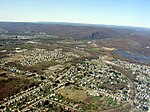Spring Brook (also known as Spring Brook Creek) is a tributary of the Lackawanna River in Lackawanna County and Luzerne County, in Pennsylvania, in the United States. It is approximately 17 miles (27 km) long and flows through Covington Township, Spring Brook Township, and Moosic in Lackawanna County and Pittston Township in Luzerne County. The watershed of the stream has an area of 57.2 square miles (148 km2). It is designated as a High-Quality Coldwater Fishery and a Migratory Fishery above Interstate 476 and as a Coldwater Fishery and a Migratory Fishery below it. A section is also designated as Class A Wild Trout Waters. The stream's tributaries include Panther Creek, Plank Bridge Creek, Rattlesnake Creek, Green Run, Monument Creek, and Covey Swamp Creek. It has a relatively high level of water quality and is very slightly acidic, with a pH of 6.4 to 6.9.
The upper reaches of the watershed of Spring Brook are mountainous and swampy. Further downstream, the stream flows through a water gap in the Moosic Mountains. Sandstone, shale, and some coal are present in the vicinity of the stream. It has been channelized in a concrete channel for part of its length and is the main source of flooding in Spring Brook Township, Lackawanna County. The stream is the second-largest tributary of the Lackawanna River. Reservoirs on Spring Brook include the Spring Brook Intake, the Nesbitt Reservoir, the Watres Reservoir. There are three dams on the stream. The watershed is mainly forested, with only a small amount of urban land.
In the past, industries in the watershed of Spring Brook included timbering, coal mining, and agriculture. Two railroads also passed through the watershed in the early 1900s, at least one of which was established by the 1880s. The stream's watershed has served as a water supply since at least the early 1900s and still serves as a water supply for the Lackawanna Valley. Several bridges have also been constructed across the stream in the 20th century. The stream has been part of several studies since 1970. Part of its length is navigable by kayaking, paddling, and rafting.





